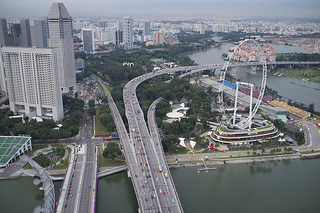 The logistics and transportation industry in Singapore has a positive outlook, and the government is urging industry players to harness technology and e-commerce to further accelerate the sector’s growth, said a senior government official.
The logistics and transportation industry in Singapore has a positive outlook, and the government is urging industry players to harness technology and e-commerce to further accelerate the sector’s growth, said a senior government official.
In his recent speech at a local logistics and transportation conference, Lee Yi Shyan, Senior Minister of State for Trade & Industry and National Development, said the sector is projected to expand at a compound annual growth rate of 6.2 percent to reach over US$40 billion in 2016.
“The logistics and transportation industry plays an important part in our economy. It is a key enabler for manufacturing, trading and services industries,” said Lee.
Last year, the sector contributed about 7 percent of the state’s GDP and employed some 227,000 workers, he added. “This year’s World Bank Logistics Performance Index continues to rank Singapore as the top logistics hub in Asia. Singapore is also recognized as the world’s largest container transhipment hub, handling more than 32 million containers in 2013.”
He said growth of the logistics and transportation sector in Singapore is founded on two factors. One is that it has become the choice location for leading manufacturers in industries such as semiconductors, electronics, and chemicals.
“Key industry players have based themselves in Singapore, and centralized key functions such as sourcing, procurement, supply chain planning, and network design here. With Asia playing a greater role in global supply chains, our logistics companies are well positioned to take advantage of this to grow along with our manufacturers,” he continued.
The second factor is the expected broad growth in trade and other services, which will drive demand for logistics services. “The growth of e-commerce in the region, for example, will provide opportunities for retail-focused logistics companies,” he continued.
“More generally, strong business developments in China and India is set to drive double-digit growth in the overall Asia-Pacific 3rd Party Logistics (3PL) market over the next 5 years. This year alone, B2C ecommerce transactions in Asia-Pacific are expected to reach over $525 billion, making it the largest regional ecommerce market.”
Recognizing the need to take advantage of new technology and improve logistics processes, Lee said the Economic Development Board and SPRING (Standards, Productivity and Innovation Board) Singapore have embarked on a S$42-million, five-year productivity roadmap for the logistics industry.
“The roadmap contains a suite of capability-building initiatives that have benefitted more than 180 logistics enterprises since it was launched in March 2012,” he said.
Some of the recent productivity initiatives for the logistics sector that SPRING has supported include the Mobileye initiative, an effort to incorporate the use of assistive driver technology for safety, and Software-as-a-System Total Logistics Information System, a low-cost cloud computing technology solution tailor-made to support logistics management.
“As more businesses adopt the Internet of Things in their operations, such technology is likely to become the standard tools for logistics operations,” he continued, adding that the Internet of Things has “the potential to drastically change the playing field for logistics companies.”
By 2020, up to 50 billion devices will be connected to the internet, generating and consuming massive data, Lee said. “Logistics companies that succeed in implementing real-time management of their operations will be able to improve service offerings and reduce costs. Capabilities such as fleet optimization, dynamic supply-chain tracking and tracing, big data management and analytics, and real-time security are up and coming in the sector.”
Given the rapid development of the industry, the industry in Singapore has to be among the first adopters of IT and smart technologies for “optimal resource utilization and productivity,” and to continue to update and innovate to “maintain its lead as a global logistics hub,” he emphasized.
Photo: Aleksandr Zykov




